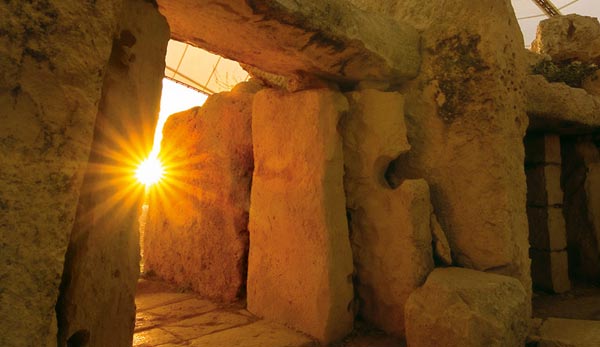This natural picturesque grotto and its neighboring system of caverns mirrors the brilliant phosphorescent colors of the underwater flora. .
Megalithic Temples
Each the result of an individual development, there are seven megalithic temples in Malta and Gozo, the oldest dating from 5,000 BC.
The oldest freestanding temples in the world are of Ġgantija on the Island of Gozo, also notable for its gigantic Bronze Age structure.
On the Island of Malta, the Ħagar Qim (decorated with animals and goddesses carved from flint and obsidian), Mnajdra and Tarxien temples are unique architectural masterpieces, given the limited resources available to their builders. The Ta’ Ħaġrat and Skorba complexes show how the tradition of temple building was handed down in Malta.
Blue Grotto
This natural picturesque grotto and its neighboring system of caverns mirrors the brilliant phosphorescent colours of the underwater flora. The Blue Grotto is located near “Wied iz-Zurrieq” south of the town of Zurrieq. A number of caves, including the Blue Grotto, which is the biggest one, can be reached by boat from Wied iz-Zurrieq. From Wied iz-Zurrieq one can also see the small island of Filfla. Filfla is uninhabited except for a unique species of lizards that live there. When Malta was a British colony, the island of Filfla was used for target practice by the British Armed Forces. The island is now protected under Maltese law. The scenery around this area of the island is breathtaking. The cliffs rise out of the blue Mediterranean and the froth of the waves as they hit the rock face can make for some excellent shots.
Marsaxlokk Bay
Marsaxlokk Bay is Malta’s second largest natural harbour. It is the best place to see the colorful, traditional Maltese fishing boats, the Luzzus, with the mythical eye painted on their prows. The village is the Islands’ main fishing harbour; its Sunday fish market a fascinating insight into local life and a traditional industry. The stalls brim with the night’s catch – fish of all shapes, colours and sizes. The village itself has many good fish restaurants. Marsaxlokk derives its name from the Arabic word marsa, meaning harbour, and Maltese for the south-easterly Mediterranean wind, the Xlokk (Sirocco in Italian). Marsaxlokk, with its sheltered habour, was an easy landing place for pirates and the Ottoman Turks. It was here that the Ottoman Turks landed for an attack which ended in the Great Siege of 1565. Napoleon’s army landed here in 1798; and in recent times, the harbour was the scene of the Bush-Gorbachev Summit,1989. The headland to the left of the Bay is Delimara Point. It has two attractive, secluded rocky inlets suitable for swimming: Peter’s Pool; and the furthermost part of the headland. Fort Delimara, on the west of the peninsula, was built by the British in 1881 to guard the entrance to Marsaxlokk Bay.
Source:



